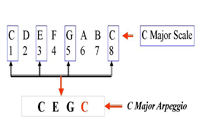Playing Arpeggios on the Piano
Have you ever tried to play arpeggios on your piano? Do you know what they are?
If you know how to play different scales or chords on the piano then you will be able to understand the answers given for the questions above.
If you can play a triad or chord on your piano or keyboard and then play each note in the chord one after the other, then you can say yes to the first question above. Arpeggios can be simply described as broken chords. The notes in the chord are played one after the other instead of playing them simultaneously. All chords whether they are major, minor or diminished can be played in a broken pattern forming a specific melody.
The word arpeggio comes from the Italian word “arpeggiare”, which means to play on a harp. A harp is a perfect instrument to use in our example because broken chords are played more dominantly on this instrument than any other. The notes that make up the chord are played one after the other and are done in ascending and descending order. It is important to note that the octave of the root note in the chord or scale is included in this melodic pattern. Therefore it would be correct to say that an arpeggio includes the first, third, fifth and eight notes of a major or minor scale.
The illustration below should help. It is showing how a broken chord is constructed from a major scale.

If you know how to play major and minor scales well, then you will have no problem playing broken chords. All the different types of broken chord can be represented on the staff or stave and it is easier than it seems. Once you know the letter name for each line and space on the staff or stave fluently, then you will have no problem representing and identifying a broken chord. At this level, the focus will be on some of the broken chords formed from major scales.
Below are illustrations showing some of the broken chords formed from major scales and how they are played on the piano.






The numbers that exist under the letters in each illustration above are placed there to indicate the position of each note in their specified major scales.
Broken chords are dominant in classical music. However, they are used in every genre of music today. They can also be used as great finger exercises for piano players at all level.
Related piano lessons on this website for beginners
Exploring Piano Intervals on the Keyboard
Playing Major Scales on the Piano
Piano Blues Scale Lessons for Keyboard Players
Playing the Circle of 5ths on the Piano
Click here to leave the arpeggios page and return to home page!
Subscribe to receive free piano lessons
E-zines and other updates!










